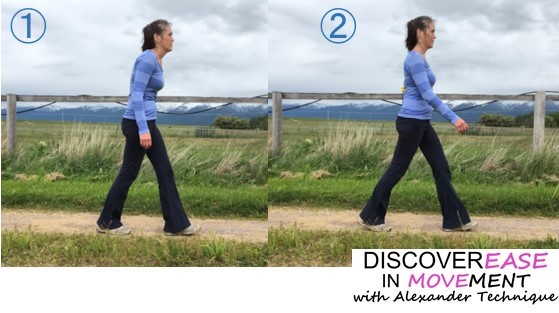1) In image 1, I’m pulling my head down and pushing it forward as I brace my torso and arms, limiting my stride.
2) In image 2, my head is releasing up, allowing my body to lengthen and my limbs to move freely.
Walking is a fantastic way to get moving and walking more is one of the best things you can do for yourself, I think. It’s a great way to get so many muscles and body parts into play. How you walk also plays a big role in ease, balance, comfort, benefit and enjoyment.
One of the most common issues I see people have with walking is that of restricting their movement. We humans have “central pattern generators” that, among other things, activate a rhythmic walking gait, activating the right muscles at the right time and producing movement throughout the whole body.
A lot of factors can lead us to change and interfere with the way we walk. Imagine, for example, that you have a pebble in your right shoe. You will probably start keeping your right foot in the air longer, leading to a limp. When we’ve experienced or are experiencing pain, we tend to hold and brace, and we adapt our gait as a result. Immobilization of an injured part tends to last longer than the time required for the body part to heal, so we start to adapt the way we move to keep immobilizing the part unconsciously. Habitually tightened muscles also limit movement, as do habitually lax muscles. These adaptations take root and affect whole-body movement, including the way we walk.
Over time, we tend to begin to restrict our movement. If we keep doing that, eventually we move less and less to the point that movement triggers danger signals to the brain, which may decide to protect you with pain. (Read more about how pain happens.)
We can reverse this process! It is possible to get your body moving with greater ease, fluidity and comfort. I’ve seen this in myself as I learned how to get myself out of chronic pain, and I see it over and over again with DiscoverEase in Movement students.
How do you do it? Here are some tips for making walking easier.
1. Be present as you walk
Begin to pay attention to how you walk. Do you walk differently depending on what you’re doing or what you’re planning to do? Where does your weight fall? What are you doing with your head? Most of our movement is controlled by unconscious habit. Finding out what you’re doing now is helpful for figuring out how to get to where you want to be!
2. What ARE you doing with your head?
Your head weighs considerably, and if you’re pushing your head forward or pulling it down, it’s putting a heavy load on your back and the rest of your body. That leads to compensating with extra effort, stiffness and pain. When your head is not balanced on top of your spine, your balanced will also be negatively impacted. Your head gets appropriate support from your body when it’s resting easily on top of your spine.
3. What movement are you restricting?
Walking is a whole-body movement. Begin to notice if you are holding any of your body parts in place, like your arms, torso or head. Limiting the movement of any of those parts will limit the rest and will lead to stiffness and discomfort, which leads to more holding – in a vicious cycle. And when some of the parts are working too hard, others aren’t doing their jobs. You may not be dancing, but let everything get moving as you walk!
Where to learn more
A new 5-week Walking with Ease class is starting on Monday, June 29 at 9:00 a.m. We’ll be improving balance, stride and freedom of movement. Join me at The Women’s Club for some walking fun! See the Class Schedule for more information.
Wishing you ease and flow,
Mari
DiscoverEase in Movement


Recent Comments